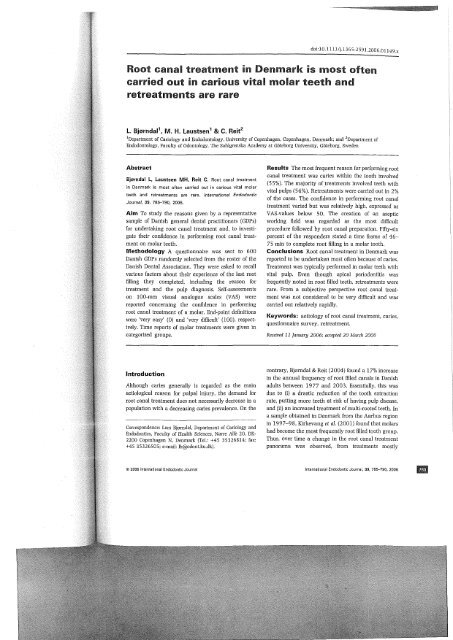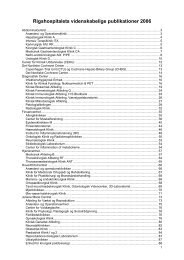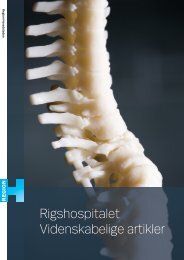View - CTU
View - CTU
View - CTU
You also want an ePaper? Increase the reach of your titles
YUMPU automatically turns print PDFs into web optimized ePapers that Google loves.
doi:l0.1111/j. l 3 6 5-2591.2006.01149 .x<br />
Root canal treatment in Denmark is most often<br />
carried out in carious vital molar teeth and<br />
retreatments are rare<br />
L. Bjarndal 1 , M. H. Laustsen 1 & C. Reit 2<br />
1 Department of Cariology and Endodontology, University of Copenhagen, Copenhagen, Denmark; and 2 Department of<br />
Endodontology, Faculty of Odontology, The Sahlgrenska Academy at Giiteborg University, Giiteborg, Sweden<br />
Abstract<br />
Bjorndal L, Laustsen MH, Reit C. Root canal treatment<br />
in Denmark is most often carried out in carious vital molar<br />
teeth and retreatments are rare. International Endodontic<br />
Journal, 39, 785-790, 2006.<br />
Aim To study the reasons given by a representative<br />
sample of Danish general dental practitioners (GDPs)<br />
for undertaking root canal treatment and, to investigate<br />
their confidence in performing root canal treatment<br />
on molar teeth.<br />
Methodology A questionnaire was sent to 600<br />
Danish GDPs randomly selected from the roster of the<br />
Danish Dental Association. They were asked to recall<br />
various factors about their experience of the last root<br />
filling they completed, including the reason for<br />
treatment and the pulp diagnosis. Self-assessments<br />
on 100-mm visual analogue scales (VAS) were<br />
reported concerning the confidence in performing<br />
root canal treatment of a molar. End-point definitions<br />
were 'very easy' (0) and 'very difficult' (100), respectively.<br />
Time reports of molar treatments were given in<br />
categorized groups,<br />
Results The most frequent reason for performing root<br />
canal treatment was caries within the tooth involved<br />
(55%). The majority of treatments involved teeth with<br />
vital pulps (54%). Retreatments were carried out in 2%<br />
of the cases. The confidence in performing root canal<br />
treatment varied but was relatively high, expressed as<br />
VAS-values below SO. The creation of an aseptic<br />
working field was regarded as the most difficult<br />
procedure followed by root canal preparation. Fifty-six<br />
percent of the responders stated a time frame of 46-<br />
75 min to complete root filling in a molar tooth.<br />
Conclusions Root canal treatment in Denmark was<br />
reported to be undertaken most often because of caries.<br />
Treatment was typically performed in molar teeth with<br />
vital pulp. Even though apical periodontitis was<br />
frequently noted in root filled teeth, retreatments were<br />
rare, From a subjective perspective root canal treatment<br />
was not considered to be very difficult and was<br />
carried out relatively rapidly.<br />
Keywords: aetiology of root canal treatment, caries,<br />
questionnaire survey, retreatment.<br />
Received I I January 2006; accepted 20 March 2006<br />
Introduction<br />
Although caries generally is regarded as the main<br />
aetiological reason for pulpal injury, the demand for<br />
root canal treatment does not necessarily decrease in a<br />
population with a decreasing caries prevalence. On the<br />
Correspondence: Lars Bjorndal, Department of Cariology and<br />
Endodontics, Faculty of Health Sciences, Norre Alie 20, DK-<br />
2200 Copenhagen N, Denmark (Tel.: +45 35326814; fax:<br />
+45 35326505; e-mail: lb@odont.ku.dk).<br />
contrary, Bjmndal & Reit (2004) found a 17% increase<br />
in the annual frequency of root filled canals in Danish<br />
adults between 19 77 and 2003. Essentially, this was<br />
due to (i) a drastic reduction of the tooth extraction<br />
rate, putting more teeth at risk of having pulp disease,<br />
and (ii) an increased treatment of multi-rooted teeth. In<br />
a sample obtained in Denmark from the Aarhus region<br />
in 1997-98, Kirkevang et al. (2001) found that molars<br />
had become the most frequently root filled tooth group.<br />
Thus, over time a change in the root canal treatment<br />
panorama was observed, from treatments mostly<br />
© 2006 International Endodontic Journal<br />
International Endodontic Journal, 39, 785--790, 2006








